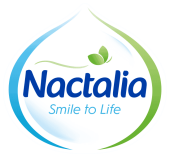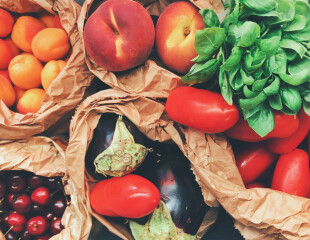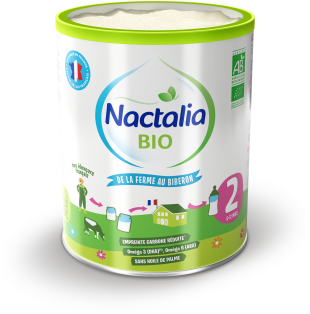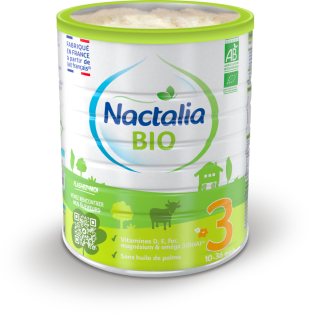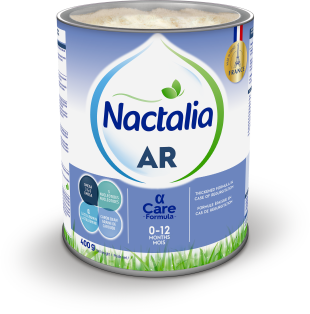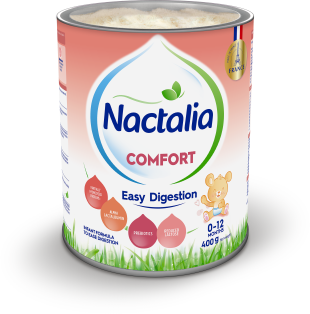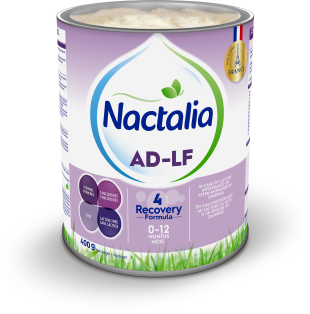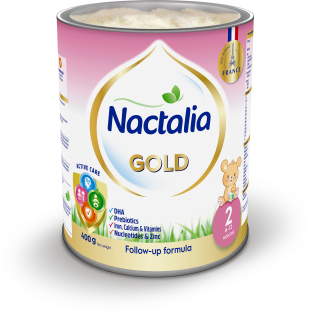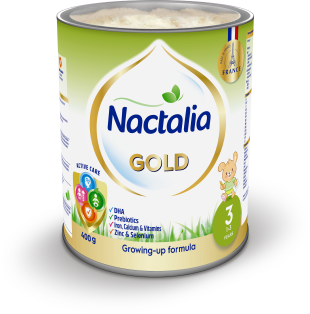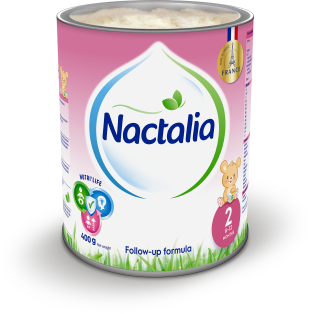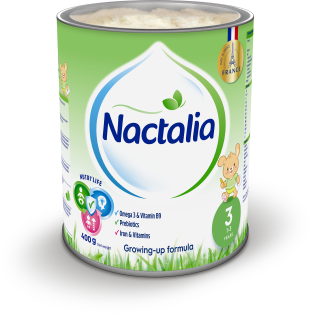
The importance of essential fatty acids in baby’s diet
Did you know? Your baby’s brain is far from being fully-developed when they are born! And essential fatty acids (EFA)* play an important role in brain development. They are fats and must be provided in baby’s food.
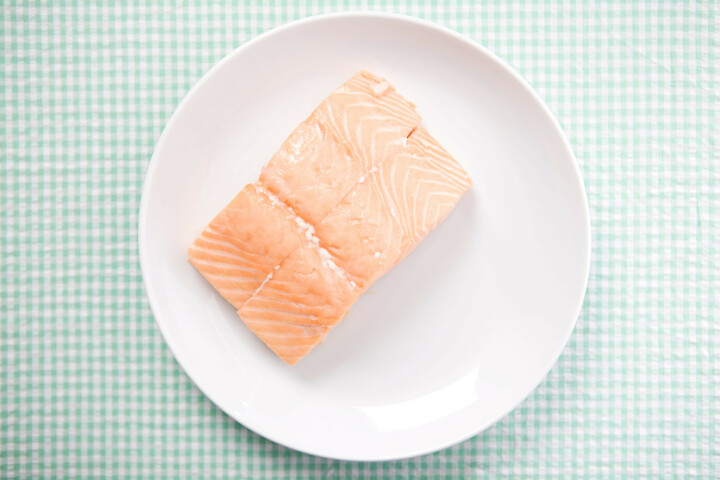
EXPERT ADVICE: Omega 3 and Omega 6
There are 2 EFA families, Omega 3 (the most important for cerebral development) and Omega 6. In each family we make the distinction between precursor fatty acids, which are truly essential and must be provided in food as the human body is unable to produce them itself, and superior derived fatty acids (long-chain polyunsaturated fatty acids or LC-PUFAs) which can be made by humans from the precursors, but in relatively small quantities. Due to the important role they play in cognitive, nervous and visual development in babies, it is a good idea to provide these LC-PUFAs in baby milk products in addition to the precursors. Precursor EFAs and LC-PUFAs are found in breast milk.
In addition to the role they play in cerebral development, the LC-PUFAS also play an important role in many other physiological functions.
Breast milk and infant milk: prime sources of Essential Fatty Acids
Whilst your baby is being breastfed or consuming the correct quantities of infant milk** for their age, their essential fatty acid requirements are met. In fact, breast milk provides precursor EFAs and LC-PUFAs in sufficient quantities to ensure that all of the baby’s nutritional needs are optimally met. Infant milks always contain the two precursor essential fatty acids to meet the nutritional needs of babies, and are sometimes supplemented with LC-PUFAs.
Note that cows milk contains very few omega 6 essential fatty acids and almost no omega 3 in comparison with breast milk and infant milks.
As soon as food diversification commences and up until the age of 3, milk (2nd stage milk, then growth milks towards 10/12 months, or breast milk), dairy products and cheeses must continue to be a major part of your child’s diet, particularly in terms of calcium provision, but also for provision of macronutrients (lipids, carbohydrates and proteins) and other micronutrients (vitamins and minerals).
It is a critical period for your child’s future health and diet plays a major role. A study into infants and young children in France indicated, however, that their dietary environment is very often imbalanced from a very early age, with an excess of energy and proteins, but insufficient fats and EFAs (Chouraqui et al., 2019).
In order to prevent fatty acid intake from progressively decreasing as the child consumes less breast milk or infant milk, make sure that at each meal you add a small quantity of fats to your baby’s meal (1 tablespoon of vegetable oil or occasionally a little knob of butter or creme fraiche).

EXPERT ADVICE: apart from in breast milk and infant milk, from which other sources is it possible to get these “good fats”?
- Precursor EFAs omega 3 (ALA) and omega 6 (LA) are only found in vegetable oils. It is important to opt for oils that are rich in omega 3 without excessive omega 6, such as rapeseed oil. On the other hand, oils such as corn, peanut, grape seed and sunflower oils should be avoided due to their high omega 6 and low omega 3 content. Olive oil contains predominantly oleic acid and its omega 6 concentrations and omega 3 concentrations in particular are low and do not meet the EFA requirements of a child (Briend A, Legrand P, Bocquet A, Comité de nutrition SFP. Arch Pediatr. 2014 Apr;21(4):424-38).
- The omega 3 LC-PUFAs are found primarily in oily fish (salmon, sardines, mackerel, herring, smoked trout) and in some seaweed. The omega 6 LC-PUFAs are also found in fish, and also in smaller quantities in meat and eggs.
Should I give my child fats?
The majority of children under the age of 3 do not have a sufficiently high intake of fats or their intake is not balanced, and is particularly low in alpha-linolenic acid, in docosahexaenoic acid (DHA) and in arachidonic acid (ARA).
In fact, significant fat intake is required during the first years of life to provide your child with all the energy needed for good growth and the development of their nervous system. Breast milk contains a high proportion of fats (and not only essential fatty acids)! It is therefore inadvisable to restrict your child’s intake of fats and when they start drinking cows’ milk, make sure that it is whole milk rather than semi-skimmed.
In practice: how is it possible to ensure a balanced intake of fatty acids?
Balanced meals, choosing a range of foods that are suitable for their age and always with the 3 following rules in mind:
- The addition of a tablespoon of uncooked plant-based fat (preferably rapeseed or walnut oil) or a knob of butter or cream (from time to time) at each meal in home-made dishes and in jars of prepared infant food with no added fats.
- 500ml 2nd stage/growth/breast milk each day, progressively adding dairy products to achieve the equivalent of 500 ml of milk per day until at least the age of 1 (800ml maximum after the age of 1).
- Fish, meat or eggs: 10 g per day up to the age of 1, or 2 tsp. of blended meat or fish/day, 20g between the ages of 1 and 2, or 4 tsp. or 1/3 of egg and 30g between the ages of 2 and 3, or 6 tsp. Fish is recommended 2 times per week, fresh or frozen, but not breaded fish: 1 dish of non-oil fish (cod, hake, whiting, sole, etc.) and 1 dish of oily fish (salmon, mackerel, sardine, herring, smoked trout). Certain fish that may contain PCB (eel, barbel, bream, carp, catfish), or methyl-mercury (swordfish, marlin, siki, shark and lamprey) should be avoided. Consumption of wild predatory fish should also be limited: monkfish (anglerfish), sea bass (bar), bonito, emperor, grenadier, halibut, bream, ray, sabre, tuna…
Note
The nutritional needs of an adult and a child are not the same. A child needs specific, suitable food. Children today consume too much protein and salt in particular, and not enough fats and essential fatty acids.
This is why, both in terms of choosing an infant milk and when making meals for your child, you should not forget to limit the amounts of protein and salt and to add fats, which are crucial for good growth and optimal development in your baby.
Abbreviations:
LA: linoleic acid
ALA: alpha-linolenic acid
ARA: arachidonic acid
EPA: eicosapentaenoic acid
DHA: docosahexaenoic acid
* Essential fatty acids (EFAs) include:
1/ The precursor EFAs which are truly essential (in other words, humans do not naturally produce them themselves and so they must be provided in food).
2/ and the superior derivatives, the Long Chain Poly-Unsaturated Fatty Acids: ARA in the omega 6 family, EPA and DHA in the omega 3 family
** All infant milks are enriched with precursor EFAs, but only 1/3 of them are enriched with LC-PUFAs. From 2020 legislation will require all 1st stage and 2nd stage milks to contain a LC-PUFA omega 3 (DHA) supplement.
